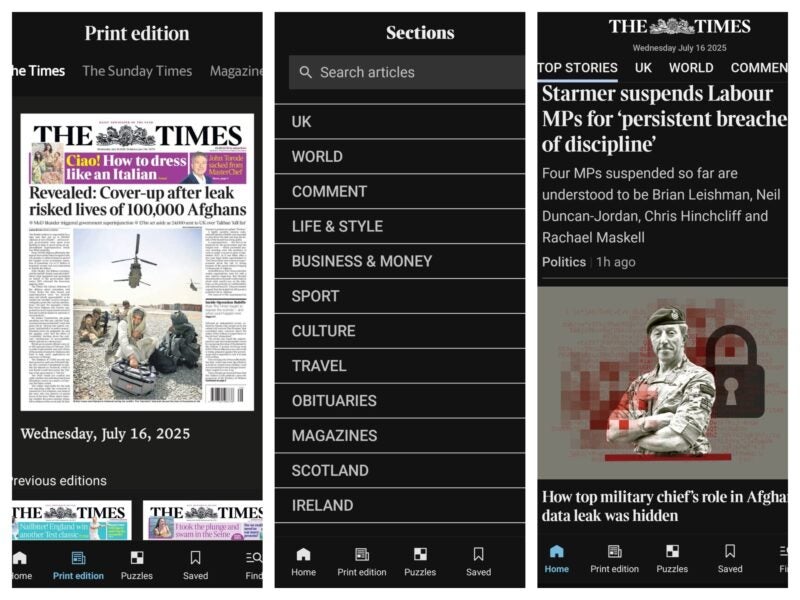
The Times of London is a brand forever associated with broadsheet journalism – but it is increasingly consumed on a 7cm-wide smartphone screen.
The Times app, which had a major overhaul in May, is now probably the title’s most financially important publishing platform.
Times Media head of digital Edward Roussel explained why the app is so key to the success of the title, what the future holds for it and why it is never going to contain AI-written journalism.
As a print title, which was broadsheet until 2004, The Times lost hundreds of millions for proprietor Rupert Murdoch. But since embracing paid-for (and increasingly mobile-first) online journalism The Times has found consistent profitability according to the limited company accounts for Times Media, which is a division of News UK.
Given The Times website is already optimised for mobile phones and tablet-sized screens, why even bother with an app?
“The really simple answer is, it’s what our subscribers prefer,” said Roussel.
The Times, Sunday Times and Times Literary Supplement claimed 629,000 digital subscribers at the end of March (up 8% year on year) and Roussel says the majority choose to read The Times on the app.
App readers are more likely to renew their subscription and they consume more content than website readers.
Roussel says three things are driving this: “One is notifications. So notification is a much more natural experience in an app environment.
“The second thing is we have page turning in our app, so you can go from one story to another and the flow of reading is a lot easier.
“And the third element of it is there’s more choice. We’ve got puzzles. You’ve got a digital newspaper, the ability to go deeper in sections, so it’s just a better experience of reading.
“And that’s not us saying that. That’s our readers saying that, and that’s where they’ve chosen to spend most of their time in our digital platforms.”
The daily print edition has probably the most prominent navigation position on the app, next to “home” at the bottom of the screen, with puzzles alongside (readers are offered 20 different games and quizzes every day).

The print edition is now far easier to access than in previous iterations of the app, with web versions of print articles opening up when they are clicked on. While the daily print circulation has dwindled to around 150,000 copies per day by Press Gazette’s estimate, even online readers appear to appreciate traditional print curation and layout.
The more substantive change to the app, says Roussel, is the organisation of content into more granular sections, paving the way for readers to select a personalised feed of stories in future iterations of the app.
He said: “We publish 1,200 stories a week, and what’s the right organisational structure of those stories, in which categories, in order to make it very intuitive to people to find stories. So for example, we’ve created a new Life & Style section. We’ve created a new Culture section. And within those areas you can go really deep. So if you love theatre, these stories are pulled together. So we’ve organised our editorial content in ways that make sense digitally rather than for print.”
Edward Roussel: Why The Times won’t be using AI to write stories
There’s no AI assistant incorporated in The Times app yet and (in contrast to some publishers) The Times won’t be using generative AI to create content any time soon.
“We don’t believe that’s a good experience for our readers. So we think that our core journalism will be human.
“I think where AI can help is in a few areas. It can help with improving search. So how do you substantially improve the search experience in websites and apps?
“We think that AI will help us with our publishing systems. So how can AI be a great assistant to an editor by ingesting, for example, our style guides, being able to kind of auto prompt different photo suggestions?
“And we think that AI can help in terms of suggesting other stories that you might wish to read based on preferences that you’ve already expressed.”
But he added: “For us, a point of principle is that we don’t believe that AI will be able to do original verification of facts. We believe that fact-checking needs to be done by humans. We believe that AI won’t be able to originate stories.”
The Times has yet to see an impact on site traffic from Google AI Overviews, with traffic up 7% year on year to 12 million UK users per month according to Ipsos Iris.
Roussel said it has been helped by the switch to a .com, rather than .co.uk domain, and other associated changes to the site architecture.
But he said they are anticipating AI Overviews will impact referral traffic in future so they are focusing on readers becoming a bigger source of referral by sharing stories. In the last month Times readers have shared 1.7 million articles, he said.
Making The Times finishable
Unlike some sites like Mail Online, the Times website and app tries to give readers a daily experience which is finite and finishable.
Roussel said: “Most home screens for most news websites, certainly in this country, are incredibly long. They could be anywhere between 80 stories and 250 stories, depending on the brands, and that’s overwhelming for readers.
“In our reader testing, overwhelmingly, readers want to feel that it’s a finite experience, so we publish in our top stories collection roughly 35 stories in the day.
“There’s a lot of painstaking work that goes into making each one of those stories truly distinctive and differentiated, and also debating the relative importance of those stories. But our starting point is we don’t want to overwhelm our subscribers. We want to give them a manageable selection of stories that they can then choose to read from.”
The Times online paywall, launched in 2010, has enabled Times Media to go from losing £72m in 2009 to making a profit of £61m in the year to the end of June 2024 on broadly level turnover.
Around a third of digital subscribers to The Times are based outside the UK and Roussel said overseas expansion remains a major focus.
The Times is the second most expensive mainstream online news subscription in the UK, costing £312 per year (discounted to £1 a month for three months to get new subscribers in). It also offers free subscriptions to different members of the same family and promotes Times content via free weekends when the paywall is removed.
Returning visitors is key success metric or Times journalism
Roussel said the key metric the team is focused on in terms of driving subscribers to renew is persuading them to return to The Times at least ten times every month.
Like Mail Online’s Deep Dives, The Times is increasingly experimenting with immersive online storytelling as a way to give subscribers more value. A recent example is a feature marking the 20th anniversary of the 7/7 London bombings which incorporated short videos, bespoke maps, graphics and animations using storytelling tool Shorthand.

Roussel has been at the top of UK digital journalism for more than 20 years, having previously worked as digital editor of the Telegraph in the mid-2000s.
What is the key thing he has learned about making journalism work in the digital age?
“Stay really close to your readers and be a very good listener to your readers.
“You need to be experimental. The world doesn’t sit still, and what’s great visual storytelling on mobile is a series of experiments, where the initial experiments are not good, and then you get better at it. The third point is to recognise that time and resource is finite, and that what you really need to focus on is quality.
“You want to provide a range of stories for people to choose from, but the quality is the success metric. And if you can maintain high standards, I believe there’ll always be a market.”
Email pged@pressgazette.co.uk to point out mistakes, provide story tips or send in a letter for publication on our "Letters Page" blog
